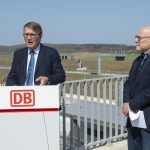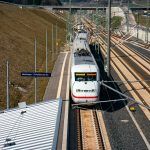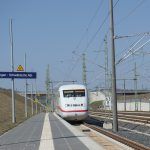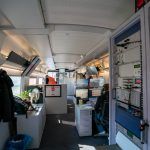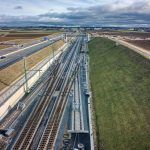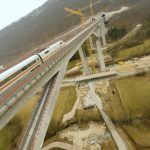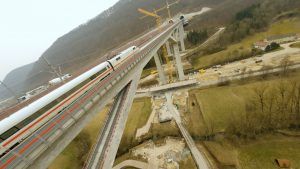 The DB Board Member for Infrastructure Ronald Pofalla and the Baden-Württemberg Transport Minister Winfried Hermann completed the test journey on the new Wendlingen–Ulm railway line. A measuring ICE-S train travelled from Wendlingen to Merklingen at a speed of 250 km/h passing several tunnels and the 85-metre-high Filstal Bridge, one of the highest railway bridges in Germany.
The DB Board Member for Infrastructure Ronald Pofalla and the Baden-Württemberg Transport Minister Winfried Hermann completed the test journey on the new Wendlingen–Ulm railway line. A measuring ICE-S train travelled from Wendlingen to Merklingen at a speed of 250 km/h passing several tunnels and the 85-metre-high Filstal Bridge, one of the highest railway bridges in Germany.
During the high-speed journey, the train drivers gradually reach a speed of 275 km/h with the ICE-S train from DB Systemtechnik. The maximum speed of 250 km/h, which will apply in the future for commercial traffic, will be exceeded by 10% during the high-speed runs to ensure the route meets all requirements.
“With the new line, we are creating a bridge to strong rail in Baden-Württemberg. Millions of travelers will benefit from being able to get from Stuttgart to Ulm and on to Munich much faster in the future – and vice versa,” Ronald Pofalla said.
The high-speed trials are another milestone for the commissioning of the Wendlingen–Ulm line on December 11, 2022. When operational, the new line will deliver passengers in Baden-Württemberg long-distance services on the Frankfurt – Munich route with a 15-minute reduced travel time, while local traffic will have an hourly connection on Ulm-Merklingen-Wendlingen. This also opens new perspectives for commuters as Ulm and Stuttgart are moving closer together, and with the Merklingen railway station providing rail access to the entire region.
The half of the 60 km Wendlingen–Ulm railway line runs through 12 tunnels, 37 bridges and is served by the Merklingen station. The new line is part of the Stuttgart–Ulm rail project which includes the Stuttgart 21 covering the reorganisation of the Stuttgart rail node and is designed to allow trains to run at a speed of 250 km/h creating the basis for more attractive journey times throughout Baden-Württemberg.
“In the future, travelers will not only be able to travel much faster between Stuttgart and Ulm on the new line. The new regional train station Merklingen – Schwäbische Alb will also connect the entire Swabian Alps region to national rail transport. This creates an attractive local transport service and an incentive to switch to climate-friendly rail transport,” the minister said.
Share on:



